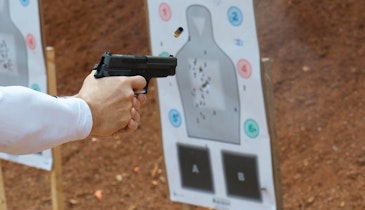As the overall shooting sports industry promises to launch an “unprecedented effort” to counter anti-gun rhetoric across the land, manufacturers are launching retailer-involved programs to offer consumers expanded long-term involvement with their guns and gear.
Steve, Sanetti, CEO of the National Shooting Sports Foundation, explained how the industry will combat a growing assault on guns and the gun culture.
In his State of the Industry speech at the Shooting, Hunting and Outdoor Trades (SHOT) Show this year, Sanetti said: “We have effective programs in place to combat the misuse of our products, and if America is genuinely serious about doing something that actually works to make America safer, persons of goodwill should see through their bias against America’s firearms industry and join us.”
For the first time in the post-Obama era, the shooting sports industry is finding itself by reinventing itself, much as it has done historically when things have gone from boom to bust to new normal.
Bluntly, the industry is going back to the future in a way that promises to deliver solid sales performance in the near and extended future. This means good things for all retailers who want to hop onto the wave and ride it all the way to the beach.
The game has changed. Gone are the days when commerce in this industry involved the simple buying and selling of hardware. That is no longer enough. In this respect, the shooting sports industry reflects general society in that the experience rules supreme.
Now, the hardware must be part of a mix that also includes education and activities that literally take consumers by the hand and walk them all the way through the process from the introduction and sale of products to the actual use of those products. The industry now is institutionalizing a process that historically was performed by parents, uncles or good friends who happened to be shooters.
Two specific efforts along these lines were unveiled at the SHOT Show in January. One was a plan being backed by a host of companies to take handloading of ammunition directly to the consumer through the retailer. The other was programming post-sale shooting and learning sessions that result in the consumer actually using the product as it was intended.
Hodgdon Powder announced a reloading effort that is similar to the road show approach the company used post-WWII.
Chris Hodgdon explained that his grandfather took the concept of reloading on the road long ago. His company and others in the reloading business that made presses, component bullets, etc. would setup big circus tents and put on events in communities around the country where shooters could learn how to reload their own ammo.
The new program announced this year will see representatives from the leading companies in the reloading business go to retail outlets and put on loading seminars for consumers.
“Train customers to reload ammunition,” a sign in Hodgdon’s SHOT Show booth stated to retailers. “Hodgdon Powder Co. will partner with you. Ask us how to host one of these events at your store.”
Hodgdon is offering the training program in partnership with Dillon Precision, Frankford Arsenal, Lee Precision, Hornady, Lyman, RCBS, Mec, Nosler, Redding and Sierra.
Retailers who want to learn more about this new program or schedule an event can contact Kent Sakamoto at Hodgdon: (913) 745 0822 or ksakamoto@hodgdon.com.
In a separate approach, Steyr announced what it calls Concierge Elite, a concept that delivers individual customer attention through the retailers. When the consumer buys and registers a Steyr rifle, they then have direct access to a person at Steyr to answer questions and help in other ways. This program involves the retailer both at the beginning, and depending on what the customer wants to do, involves the retailer downstream as well.
Conceptually, what this means is that the consumer has direct access to knowledge and advice that has not been available in the past. It marries the consumer to the Steyr family, all the way from the retailer to success at the range.
This is because, for every rifle bought for more than $1,250, the consumer has access to any of a number of training courses at Steyr’s facilities in Alabama; there are courses for carbine, scout and hunting applications.
When viewed strategically, the reloading seminars in stores, as well as the concierge approach, are intended to enhance the frequency and quality of hands-on experiences. This is an offshoot of significant industry trends over the past few years, like the focus on long-range shooting.
In fact, these kinds of efforts directly affect the ability of the consumers to realize success at longer ranges, because the handloading element affords the ability to match specific loads to specific rifles, and the training component enhances the consumers’ ability to realize more of their potential. Truly, it’s a win-win-win situation.
It is no secret that the shooting sports industry is reinventing itself in the post-Obama era. It has to, because demand during the Obama years was unsustainably high, due to fears that the government might crack down on the ability of citizens to keep and bear arms.
That spike in demand, however, involved hoards of people who were new to shooting and had no other ties to the shooting sports. Hence, many bought guns and gear, but really didn’t know how to get the most out of their purchases.
By institutionalizing programs that keep the consumers engaged in the shooting sports, and with products sold through retailers, companies in the industry now are expanding both the quantity and quality of the shooting sports experience for consumers.
No doubt retailers will find themselves becoming more and more involved in the lives of their customers, which is a connection not imagined even a few years ago.






